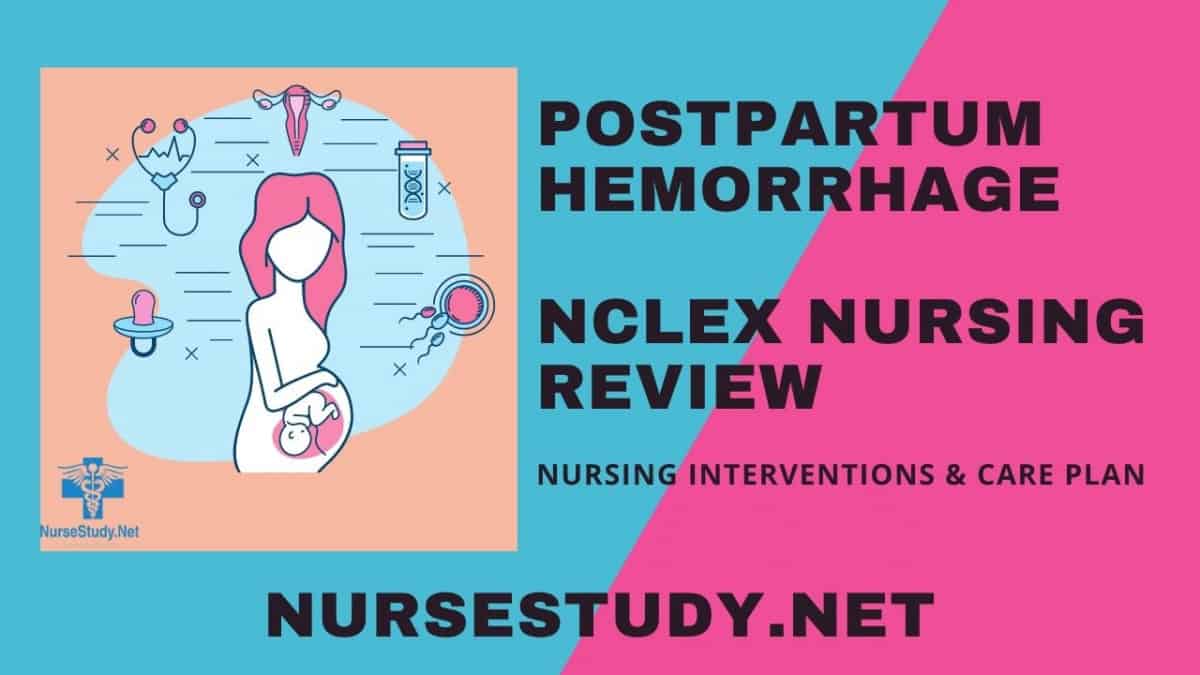Postpartum hemorrhage (PPH) represents a critical obstetric emergency requiring immediate nursing intervention. According to the American College of Obstetricians and Gynecologists (ACOG), PPH is defined as blood loss exceeding 1,000 mL accompanied by signs of hypovolemia within 24 hours of delivery (primary PPH) or up to 12 weeks postpartum (secondary PPH). As a leading cause of maternal mortality worldwide, understanding proper nursing diagnosis and care is essential for optimal patient outcomes.
Key Risk Factors
- Medical conditions: Preeclampsia, hypertension, coagulation disorders
- Obstetric factors: Multiple pregnancies, macrosomia, prolonged labor
- Previous complications: Prior PPH, previous cesarean delivery
- Placental issues: Placenta previa, placental abruption, retained placenta
- Medications: Anticoagulants, certain antidepressants
Clinical Manifestations
Primary symptoms include:
- Excessive vaginal bleeding
- Hypotension
- Tachycardia
- Decreased urine output
- Mental status changes
- Pallor and diaphoresis
Nursing Assessment
Vital Signs Monitoring
- Blood pressure
- Heart rate
- Respiratory rate
- Temperature
- Oxygen saturation
Physical Assessment
- Fundal height and firmness
- Lochia characteristics
- Perineal integrity
- Signs of shock
Laboratory Values
- Complete blood count
- Coagulation profile
- Type and cross-match
Nursing Care Plans
Nursing Care Plan 1: Risk for Shock
Nursing Diagnosis Statement:
Risk for Shock related to excessive blood loss during the postpartum period.
Related Factors:
- Hypovolemia
- Decreased cardiac output
- Inadequate tissue perfusion
Nursing Interventions and Rationales:
- Monitor vital signs every 15 minutes until stable
Rationale: Early detection of deterioration - Establish two large-bore IV lines
Rationale: Ensure rapid fluid resuscitation capability - Administer prescribed fluid replacement
Rationale: Maintain adequate circulation - Position patient flat with legs elevated
Rationale: Improve venous return
Desired Outcomes:
- Maintain systolic BP >90 mmHg
- Demonstrate adequate tissue perfusion
- Exhibit normal mental status
Nursing Care Plan 2: Deficient Fluid Volume
Nursing Diagnosis Statement:
Deficient Fluid Volume related to active blood loss evidenced by decreased blood pressure and increased heart rate.
Related Factors:
- Active hemorrhage
- Inadequate fluid replacement
- Altered coagulation
Nursing Interventions and Rationales:
- Maintain accurate I&O records
Rationale: Monitor fluid status - Assess for signs of dehydration
Rationale: Early intervention - Monitor hemodynamic parameters
Rationale: Evaluate treatment effectiveness - Administer blood products as ordered
Rationale: Replace lost volume
Desired Outcomes:
- Stabilize vital signs
- Maintain adequate urine output
- Demonstrate improved tissue perfusion
Nursing Care Plan 3: Acute Pain
Nursing Diagnosis Statement:
Acute Pain related to tissue trauma and uterine contractions evidenced by verbal reports and guarding behavior.
Related Factors:
- Tissue trauma
- Surgical interventions
- Uterine contractions
Nursing Interventions and Rationales:
- Assess pain characteristics
Rationale: Guide pain management - Provide comfort measures
Rationale: Promote relaxation - Administer prescribed analgesics
Rationale: Control pain - Monitor pain response
Rationale: Evaluate intervention effectiveness
Desired Outcomes:
- Report decreased pain levels
- Demonstrate improved comfort
- Participate in recovery activities
Nursing Care Plan 3: Anxiety
Nursing Diagnosis Statement:
Anxiety related to acute health crisis evidenced by expressed concerns and increased tension.
Related Factors:
- Life-threatening situation
- Uncertainty about outcome
- Separation from infant
Nursing Interventions and Rationales:
- Provide clear information
Rationale: Reduce fear of the unknown - Maintain calm environment
Rationale: Decrease stress - Include a support person in care
Rationale: Enhance emotional support - Listen to concerns
Rationale: Validate feelings
Desired Outcomes:
- Express decreased anxiety
- Demonstrate coping mechanisms
- Verbalize understanding of the situation
Nursing Care Plan 5: Risk for Impaired Parenting
Nursing Diagnosis Statement:
Risk for Impaired Parenting related to a maternal medical condition and separation from the infant.
Related Factors:
- Physical limitations
- Emotional stress
- Interruption in bonding
Nursing Interventions and Rationales:
- Facilitate mother-infant contact when stable
Rationale: Promote bonding - Provide breastfeeding support
Rationale: Establish feeding routine - Educate about infant care
Rationale: Build confidence - Include family in care planning
Rationale: Strengthens the support system
Desired Outcomes:
- Demonstrate effective parenting skills
- Express confidence in caregiving
- Maintain appropriate mother-infant interaction
References
- Escobar, M. F., Nassar, A. H., Theron, G., Barnea, E. R., Nicholson, W., Ramasauskaite, D., Lloyd, I., Chandraharan, E., Miller, S., Burke, T., Ossanan, G., Carvajal, J. A., Ramos, I., Hincapie, M. A., Loaiza, S., Nasner, D., & Committee, N. H. (2022). FIGO recommendations on the management of postpartum hemorrhage 2022. International Journal of Gynaecology and Obstetrics, 157(Suppl 1), 3. https://doi.org/10.1002/ijgo.14116
- Gulanick, M., & Myers, J. L. (2022). Nursing care plans: Diagnoses, interventions, & outcomes. St. Louis, MO: Elsevier.
- Loussert, L., Schmitz, T., Korb, D., Goffinet, F., & Ray, C. L. (2025). Risk of postpartum hemorrhage according to the planned mode of delivery among twin pregnancies with previous cesarean delivery. Journal of Gynecology Obstetrics and Human Reproduction, 54(1), 102861. https://doi.org/10.1016/j.jogoh.2024.102861
- Nigussie J, Girma B, Molla A, Tamir T, Tilahun R. Magnitude of postpartum hemorrhage and its associated factors in Ethiopia: a systematic review and meta-analysis. Reprod Health. 2022 Mar 9;19(1):63. doi: 10.1186/s12978-022-01360-7. PMID: 35264188; PMCID: PMC8905908.
- Post SE, Rood KM, Kiefer MK. Interventions of Postpartum Hemorrhage. Clin Obstet Gynecol. 2023 Jun 1;66(2):367-383. doi: 10.1097/GRF.0000000000000785. Epub 2023 May 5. PMID: 37204172.
- Silvestri, L. A. (2020). Saunders comprehensive review for the NCLEX-RN examination. St. Louis, MO: Elsevier.
